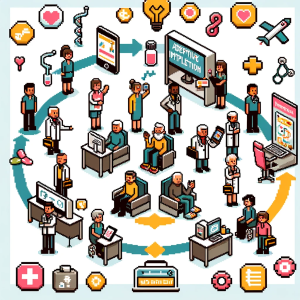How Technology is Revolutionizing Public Health: A Deep Dive into Workforce Implications
Before you go, ensure you’re always ahead of the curve! Join our weekly newsletter and get the latest in public health research distilled for your convenience. Be the first to harness the power of cutting-edge insights and stay at the forefront of knowledge. Subscribe now!
In a recent article, the critical intersections of public health, data science, and technology have been insightfully laid bare. As our understanding of public health has evolved over the last 150 years, so has the urgent need for the public health workforce to adapt, particularly in leveraging advanced technologies. This deep dive explores the implications of this nexus and suggests paths forward for public health professionals.
The Technology Transformation in Public Health
From artificial intelligence predicting outbreaks to blockchain securing health records, the realm of public health has been touched by myriad technological advancements. Each innovation offers unique capabilities that have the potential to reshape how we understand, intervene, and enhance public health. Delving deeper:
Artificial Intelligence (AI): At the heart of AI lies its capability to analyze vast data sets swiftly, making it a potent ally in public health.
- Disease Prediction and Control: AI algorithms can trawl through immense amounts of data, identifying patterns that might be invisible to the human eye. This means that before a disease outbreak becomes an epidemic, AI can raise an alert, allowing for quicker and more targeted responses.
- Optimizing Health Services: From appointment scheduling to identifying at-risk populations, AI can streamline operations, ensuring that healthcare resources are utilized efficiently.
- Understanding Patient Behavior: Through the analysis of medical histories, social media data, and other digital footprints, AI can offer insights into patient behaviors, enabling tailored health interventions.
Blockchain: Beyond the realm of cryptocurrencies, blockchain has substantial implications for health data management.
- Data Security: With its decentralized nature, blockchain acts as a deterrent against data breaches. Every data entry gets time-stamped and encrypted, ensuring that health records remain tamper-proof.
- Improved Collaboration: Institutions often face challenges sharing health data due to privacy concerns. With blockchain, data can be shared securely, with the assurance that only authorized personnel can access it. This paves the way for collaborative research and timely health interventions.
Internet of Things (IoT): The physical world meets the digital through IoT, transforming how we monitor and react to health parameters.
- Wearable Devices: From fitness trackers to glucose monitors, wearable devices provide invaluable real-time insights into a person’s health metrics. Such devices can detect abnormalities and even offer timely health advice.
- Remote Monitoring: Especially vital for elderly or chronically ill patients, IoT enables healthcare providers to remotely monitor patients, ensuring they receive timely care without frequent hospital visits.
- Environmental Sensors: Beyond individual health, IoT sensors placed in cities can monitor air quality, radiation levels, or water quality. This kind of data can guide public health interventions, ensuring communities remain safe.
As the lines between technology and public health continue to blur, it’s evident that our approach to health challenges can no longer remain traditional. Embracing these innovations can lead us to more proactive, efficient, and personalized health interventions.
Upskilling for the Future
Addressing the widening chasm between technological advancements and the skill sets of the public health workforce necessitates a multi-pronged approach. With the pace at which technology is evolving, mere awareness isn’t sufficient; proficiency becomes paramount. Unpacking the strategies mentioned, here’s a more detailed plan of action:
Competencies Framework: The first step is to anchor skill acquisition in a robust framework.
- Customized Training Modules: Data science and technology companies can collaborate with public health institutions to design tailored training modules. This bridges the gap between theoretical knowledge and practical application, enabling the workforce to seamlessly integrate tech advancements into their workflows.
- Benchmark Assessments: Periodic evaluations can measure proficiency levels, ensuring that the workforce remains current and identifying areas requiring further training. Why, this could be an area where readiness is important…..check our sister evaluation firm, The Dawn Chorus Group to learn more.
Workforce Exchanges: Immersion and hands-on experiences often lead to the most profound learning.
- Internships and Fellowships: Public health professionals can gain direct experience with cutting-edge tools and methodologies by establishing short-term positions or fellowships within tech companies. This not only imparts technical skills but also fosters a mindset of innovation.
- Collaborative Projects: Joint projects between public health agencies and tech firms can foster a symbiotic relationship, allowing for real-world application of technology in public health contexts and providing tech professionals with insights into the unique challenges faced by health workers.
Continuing Education: The path of knowledge never ends; it merely evolves.
- Online Platforms: Numerous online platforms offer courses in emerging tech fields tailored to healthcare. Platforms like Coursera, Udemy, and edX have courses ranging from health informatics to AI in healthcare.
- Workshops and Seminars: Regularly attending workshops or seminars can keep professionals abreast of the latest developments. These settings also offer networking opportunities, facilitating collaborations and partnerships.
- Accredited Programs: Consider pursuing higher education programs or certifications from reputed institutions that offer specialized curricula in health technology integration.
In an era marked by rapid technological progress, the call to action is clear: public health professionals must embrace a continuous journey of learning and adaptation. Through strategic collaborations, tailored education, and hands-on experiences, the public health workforce can catch up and lead in this technologically advanced landscape.
Policy Implications and Government Support
While promising, the amalgamation of technology and public health requires deliberate strategies and policies to facilitate its successful integration. The three key pillars—funding, partnerships, and regulation—are paramount in this transformative journey. Let’s delve into a more comprehensive exploration of these strategies:
Funding: Financial backing is the backbone of any successful transformation. When it comes to embedding technology into public health:
- Dedicated Budget Allocations: By earmarking a specific portion of the health budget for technology assimilation, governments can ensure a consistent and focused effort towards this integration. This will prioritize tech advancements in the public health domain.
- Grants and Incentives: Governments could provide grants for research and pilot projects that aim to harness new technologies in public health. Also, incentives for institutions and professionals who pioneer this field can spur more initiatives.
- Infrastructure Development: Beyond training, the establishment of technologically advanced public health labs, research centers, and data hubs can be financed, ensuring that the workforce has the tools they need at their disposal.
Partnerships: Collaborative endeavors can amplify the impact of any initiative.
- Tech Think Tanks: By fostering think tanks that bring together tech experts, data scientists, and public health professionals, a multidisciplinary approach to problem-solving can be adopted.
- Innovation Labs: Create spaces where tech companies can collaborate directly with public health agencies, brainstorming and developing solutions in real-time.
- Community Engagement: Engaging local communities in these partnerships can provide invaluable grassroots-level insights, ensuring that technological solutions are both innovative and relevant to the populace’s needs.
Regulation: While the sky’s the limit with innovation, it’s essential to keep our feet grounded in ethical considerations.
- Data Privacy Laws: Establish stringent data privacy laws that ensure individuals’ health data is protected. This fosters trust and encourages more people to participate in tech-driven public health initiatives.
- Ethical Review Boards: Set up boards that review and oversee tech projects in the public health domain, ensuring they adhere to ethical standards and respect individual rights.
- Transparency Protocols: Encourage tech companies and public health agencies to maintain transparency in their operations. This includes open communication about how data is used, the technologies employed, and the outcomes expected.
A comprehensive approach, intertwining robust funding, synergistic partnerships, and meticulous regulation, will ensure that the marriage of technology and public health not only flourishes but sets a gold standard for other sectors to emulate.
Conclusion
In an era where technology seamlessly intertwines with our daily lives, the realm of public health cannot afford to be an outlier. By embracing the transformative powers of advanced technologies, we cannot only revolutionize how we approach public health challenges but also equip our professionals with the tools and skills to navigate this brave new world. Governments, private entities, and individuals must unite, forging partnerships and crafting policies that champion innovation while upholding ethics. The future of public health is digital, dynamic, and, most importantly, collaborative. Let’s embark on this journey together, ready to learn, adapt, and innovate for a healthier tomorrow.



